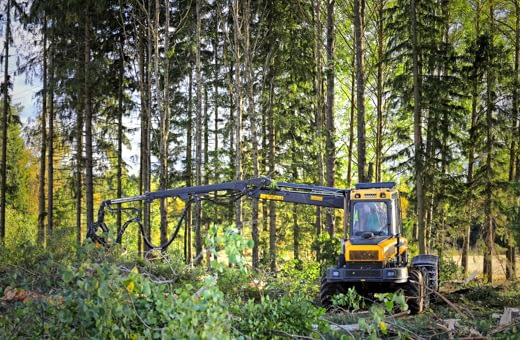In Finland, there is a strong ambition to become the best country in the world in acknowledging forest biodiversity during harvesting. This would require measuring and documenting top-class forest biodiversity indicators in connection with harvesting operations.
By using current forest machine data, it is already possible to document the high biodiversity stumps left behind during harvesting and the trees cut down around a stand of retention trees or another untreated area, such as a protective belt around a body of water, a key biotope, a conserved area or a game thicket.
In the future, we must aim for automated measuring and documentation of forest biodiversity indicators. This requires a sensor in the harvesting machine, such as an app based on laser scanning or machine vision, to produce accurate data on biodiversity indicators, such as retention tree species, diameters and volumes.
At the moment, there is no research data on measuring biodiversity indicators using forest machines equipped with modern sensors. The project ‘Towards more climate-sustainable and diverse logging through sensor technology and accurate geographical information (IlmoStar)’ , funded by the Ministry of Agriculture and Forestry of Finland and implemented by the Finnish Geospatial Research Institute, the University of Eastern Finland, the Natural Resources Institute Finland and Ponsse Plc, demonstrates the performance of future harvesting machines in measuring and tracking forest biodiversity indicators between 2023 and 2025. The IlmoStar project is part of the land use sector’s Catch the Carbon climate action package launched by the ministry in the spring of 2020.
The production of accurate and automated biodiversity information with forest machines equipped with sensors is expected to become a reality during this decade. Moving forward, forest machine data and an advanced sensor system can also be used to instruct and remind the operator of the machine to leave behind groups of retention trees, large broad-leaved trees, decaying wood and game thickets, increase the share of broad-leaved trees and prepare high biodiversity stumps in optimal locations. The sensor system can also warn the operator against driving over decaying wood when harvesting.
And, more importantly, operators will be able to use the data measured with forest machines to report the acknowledgement and status of forest biodiversity to forest owners after the harvesting operation.
Aerial remote sensing data, the traditional forest machine data and the data produced by the sensors installed on forest machines are mutually supplementary. For example, aerial remote sensing materials are a great way to see the crown of the tree and its condition. Forest machine sensor data, in turn, depicts the geometry of the trunk and some of the branches. By combining these sources of data, we can plan targeted nature management methods that effectively conserve biodiversity while assisting the machine operator in carrying out the planned work.
In the next few years, forest machine data enriched with sensor data and combined with remote sensing data will create an excellent opportunity for taking a major leap in measuring and tracking forest biodiversity indicators and reporting our forest biodiversity handprint and footprint. In order to take this leap, we need significant investments in research and technological development.
Kalle Kärhä, University of Eastern Finland | Jukka Malinen, Metsäteho Oy | Juha Hyyppä & Harri Kaartinen, Finnish Geospatial Research Institute







